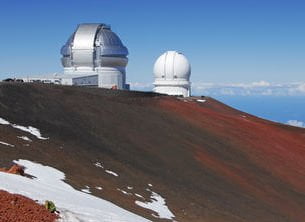The conflict between Native Hawaiians, scientists, government and its legal system over construction of The Thirty Meter Telescope (TMT) is very complex, involving issues of indigenous rights, sovereignty and environmental stewardship. The TMT is not the first such project to break ground on Mauna Kea. Rather, over the course of 50 years, thirteen telescopes have preceded it, ever since Hawaii and the University of Hawaii foresaw the possibilities of an astronomy boon for the economy.
For scientists, Mauna Kea’s summit is an ideal site in the northern hemisphere, even the world, for astronomy and its quest to find signs of extraterrestrial life. The Hubble space telescope can see objects 200 times sharper than Galileo’s telescope. The TMT will be able to see objects three times sharper than the Hubble: planets orbiting stars, details of the galaxy at the beginning of time. Understandably this is all very exciting for scientists, but even current astronomy facilities already threaten Mauna Kea’s fragile ecosystem and have destroyed habitats for native species.
The summits of both Mauna Kea and Haleakalā are home to unique ecosystems and rare and endangered species, many of which are found nowhere else on our planet. These summits are themselves part of the larger ecosystem of the entire Big Island. And each of these volcanoes is part of a complex and uniquely Hawaiian eco-cultural system involving freshwater, land, plants, animals, ocean, and people. Managed today by the state of Hawaii and the University of Hawaii, Native Hawaiians have never relinquished their claims to either Mauna Kea or Hawaii’s almost 2 million acres of land.
No surprise, therefore, that TMT has resulted in Native Hawaiians mobilizing around aloha ‘aina, their core philosophy that translates into deep love of the land and guides the relationship of Hawaiians to Mauna Kea and the rest of Hawaii’s environment. Guided by aloha ‘aina, protesters refer to themselves as “protectors” making a stand for their native land and Hawaiian culture. They view TMT as an act of cultural desecration that also is detrimental to the ecosystem. Protests that began locally have gone global, especially after the Supreme Court of Hawaii validated TMT’s construction permit a year ago.
Adding to the complexity of the conflict, polling has consistently shown that a majority of Hawaii voters support the construction of the telescope by a margin of more than 2-to-1. Polls even have shown that a majority of Native Hawaiian support the TMT project. So what really is at stake? How should visitors to Hawaii interpret the conflict between Native Hawaiians and most of Hawaii’s population? Is this just a case of native beliefs versus modern science or is something more fundamental in play?
For those of us who help visitors find their way to and experience Mauna Kea, this great mountain symbolizes the conflict between different ways of knowing and experiencing the world. For many Native Hawaiians and other indigenous peoples elsewhere, sacredness means much more than merely a concept. It is a lived experience of oneness and connectedness with both natural and spiritual worlds. Native Hawaiians are not protesting science. They are embracing some of the same core values that attract visitors to Hawaii.
Visitors are attracted to the Hawaii because it lies far out in the middle of the Pacific and far off the beaten path. Yes, the atmosphere is much cleaner and mountains like Mauna Kea are the best places on the planet for astronomical observatories. But since climate change and other mounting environmental issues are pushing more and more people to view our planet’s environment as challenged and even in jeopardy, increasing numbers of non-indigenous peoples are coming to places like Hawaii in search of a genuine respite and, at the same time, are truly respectful of the need for stewardship for our planet and its special places like Hawaii.

